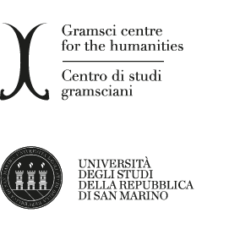1. The double header – Gramsci centre for the humanities / Centro di studi gramsciani – is not only a very free presentation of the same content in two languages. It also refers to a double function. On the one hand, the scientific observation of Gramsci’s work, his lecture, his method; on the other hand, research on some of Gramsci’s themes – organization of cultural work; intellectuals; politics and culture… – in their current implications: in new terms.
They are different grounds, rather extensive to say the least, but with a common inspiration and clear thematic points of contact.
For the first aspect, which is one of historical research, the centre of San Marino intends to collaborate with all the institutes – whether or not they are linked, because of their history, to the Communist leader Gramsci – which carry out scientific research on the work of the Sardinian thinker.
For the second aspect, the centre will be able to look for collaborations in a very varied field, because it will work in a disciplinary field still in training: “humanities” (digital, non-digital, pre-digital, early digital…), knowledge technologies, knowledge design, design of cultural enterprises.
In this field all “humanities” institutions and practices are now redefined. Each of them could produce a separate research project, specific projects in which the centre will commit itself, on the basis of available resources: from the library to the bibliography, from the filing cabinet to the archive, from the collection of objects to the museum and exhibition, from the conference to the lecture, from the article to the book to the scientific and cultural journal, from the book review to the public presentation of works: the list could be quite long.
It is a question of reflecting on the technique, without limiting oneself to the observation, or automatic adoption, of the latest technical revolution; teaching the new techniques, knowing how to use them, innovating their use; understanding the new techniques as such, even in relation to those that are not new. To establish what are the economic, social, cultural, intellectual, political implications of the design and use of technology. To study the new landscape that these techniques have created, without forgetting that many practices have changed from a very ancient tradition.
In the new disciplinary field in formation, there is sometimes an evident technical drift (a technical drunkenness, almost): unthinkable things are now possible, and are done with relative ease. Where is the space to think, to design new things? Sometimes they are old things, made with new techniques; sometimes they are new things, and the time has come to stop and think about them, understand their meaning, re-design them.
2. In the first two years of activity, the center will start research and initiatives that take into account the “double function” mentioned above, without prejudice to the common inspiration.
a) For the work of historical research on Gramscian thought, the first theme will be the tradition, in a philological sense, of Gramsci’s work in the period 1937-1947, from Gramsci’s death to the publication of the first volume of the Einaudi edition;
b) In collaboration with the University of Modena and Reggio Emilia, the centre will start a research on the art of extracts, on the techniques with which the scholars used to read and extract the best passages from their own readings, and then set them aside in some particular order, in view of the preparation of oral speeches or the production of new texts, in a long-term process that goes from the classical and medieval florilegy to the personal archive or file, now also digital, online, public;
(c) in collaboration with the University of Strasbourg, the centre will undertake research on Machiavelli during the Cold War. Dionisotti wrote that the image of Machiavelli in the first half of the twentieth century “faded that repellent Machiavellianism that the political crisis of Europe had exhumed and put into fashion”. The research aims to investigate what happened in the post-war situation of the Cold War: how scientific research and the historical-political context intertwine.
d) Within the courses of the School of Historical Studies, “parallel” initiatives of the centre will be proposed: conferences, seminars, working groups, possibly held also with the participation of scholars invited for doctoral lessons;
e) in collaboration with the Sapienza University of Rome, the center will organize two seminars, dedicated to Gramsci, the media and popular culture with the students of the PhD in Music and Entertainment of the Sapienza University;
f) In addition to research activities, the centre aims to train designers, designers, authors, organizers, curators, etc., professionals in the design, design, invention, innovation in humanistic or humanities practices. It is proposed the activation, from the next academic year, of a 2nd level master’s degree in Historical Communication.

